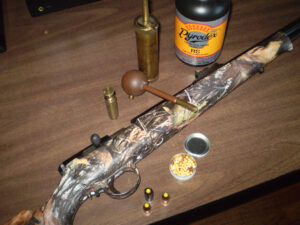Blackpowder Mistakes

By Al Raychard
Sometimes we take things for granted, or just neglect to do things which in the pursuit of whitetails with a muzzleloader can prove a major mistake. I dare say most muzzleloader hunters these days hunt with in-lines and load up with one of the available blackpowder substitutes. There are good reasons for that. Whether it’s one of the Pyrodex types, Triple 7, Blackhorn 209 or something else, for the most part today’s substitutes are less dirty, slightly more powerful and consistent. There are pros and cons of each individual brand, of course, but I doubt hunting with a muzzleloader would not be as popular today if the in-line and substitute propellants had not come along.
Keeping Powder Dry
Although some makers claim their products to be impervious to dampness, or non-hygroscopic as the wording goes, and as good as most substitutes are compared to blackpowder under the right conditions and over time all are susceptible to prolonged foul weather conditions and especially extreme variations in temperature. And, how long before a substitute fails or performs with less than maximum effort depends on the severity in weather extremes and temperature. It can be a week, a month or an entire season. It varies and not set in stone.
Maine weather conditions are notorious for being pretty harsh during the December muzzleloader season. Rain, sleet, snow and low and high variations in outside temperatures are nothing unusual. Then there is the habit many of us have of transporting our muzzleloaders from a warm house or camp to cold outside temperatures and then back into a warm truck or dwelling day-after-day. All this can affect a propellants reliability and potency. In the end the one way to insure a reliable ignition with maximum results is to keep your powder dry. Doing so can be a pain in the rear end but unless you’re willing to take a gamble it’s just part of hunting with a muzzleloader in extreme weather conditions.
Temperature Critical
There are a couple ways to do this, and which is best is up to you. At this time of year try keeping your muzzleloader at the same relative temperatures at all times. If you’re hunting in 32-degrees all day, or whatever the temperature try securing it in a safe place at the same temperature instead of taking it into a warm environment. This will prevent condensation from building and affecting the propellant. This isn’t always possible so an alternative is to discharge the gun at the end of each day. Many inline models have removal breech plugs. If that’s the case remove the plug, powder or pellets and projectile. Either way you’ll start off with a fresh load the next day or next time out.
This sounds like a pain, a waste of propellant and bullets, and to some completely unnecessary. My only answer is based on personal experience having hunted with muzzleloaders for a few decades now, maybe it is, maybe it’s not. Do you really want to find out when the moment to pull the trigger comes along?
For more articles about hunting, fishing and the great outdoors, be sure to subscribe to the Northwoods Sporting Journal.
